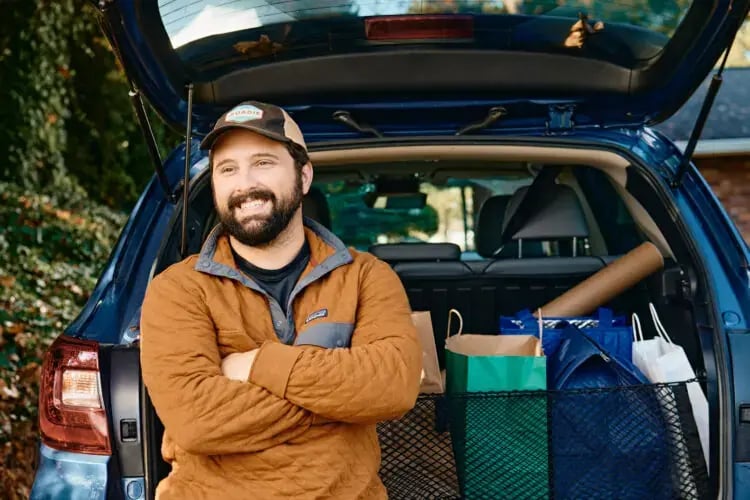
With global e-commerce sales expected to exceed $5.5 trillion this year and hit $7.4 trillion by 2025, the race is on to get final retail distribution points as close to the end customer as possible.
Fulfilling online orders directly from existing retail stores is one approach that’s working well.
It helps retailers turn over their stock faster, close final-mile logistics gaps and speed up the delivery process. By doubling as fulfillment centers, stores can also lower delivery costs, offer same-day delivery and minimize dreaded stockouts, overstocks and markdowns.
Retailers have mastered curbside delivery and the buy online pickup in store (BOPIS) model over the last two years, but most rely on third parties to bridge the physical gap between their stores and customers. Crowdsourced buy online deliver from store (BODFS) — a fulfillment approach that took hold when the pandemic turned traditional sales and logistics models on end — ensures orders are delivered on the day they are placed — even within a few hours.
Roadie’s crowdsourcing model gives retailers instant access to a network of drivers ready to deliver on-demand. As a person-to-person delivery platform that enables same-day service, Roadie puts the power of BODFS into the hands of retailers — who don’t have to invest in vehicles, drivers and other fleet-related expenses.
Getting the highest returns from crowdsourcing for BODFS takes some effort, however. It’s not enough to carve out a corner of the retail stockroom and use it to pack orders. The best results come when someone is in charge of the effort, the transaction is well defined and promotions are put in place to bring customers on board.
Follow these tips to optimize this delivery channel and use it as a competitive advantage.
Put a same-day delivery sponsor in charge
Success with BODFS isn’t something you should leave up to chance and hope it goes well. Ideally, the sponsor should be a corporate executive who pioneers the use of crowdsourced BODFS and guides strategy from Day One. The sponsor determines where same-day delivery fits into the retailer’s overall fulfillment approach, oversees the implementation process and puts the right infrastructure in place — for example, staging merchandise for packing, training employees and developing the wayfinding that will guide them through the physical environment. With a sponsor leading the charge, the odds of long-term BODFS success will be much higher.
Figure out which orders ship via BODFS and who pays the delivery fee
Clearly define which types of orders can be delivered from the store for same-day delivery. Factors to consider include order cost and size as well as delivery ZIP code and customer type. Then, ask yourself questions like: Who’s going to pay the delivery fee? Are we going to subsidize it as a part of our promotional strategy? Are we going to charge customers for it (and if so, how will we do that)? If you haven’t charged for delivery before, test a few options to see what works. Try charging your customer $4.99 or $8.99, and then try charging them nothing, and see how that affects demand. By playing around with these dynamics, you can come up with a charge that’s acceptable to buyers who want and need same-day options.
Use promos to encourage more customers to use BODFS
Setting up your store operations for same-day delivery is one thing, but your customers won’t use it if they don’t know it exists. To raise awareness, consider what promotions, marketing or advertising you can do, or what price incentives you can offer. If this is your first time offering same-day delivery, give customers a taste by making their first delivery free. Roadie has worked with many companies that have used this approach successfully.
Promotions are also great competitive tools. One large pet supply retailer that uses crowdsourced BODFS has been able to beat out the competition and increase its e-commerce sales by running an annual free, same-day delivery promo. Its customers have responded well to having pet food delivered to their doorsteps the day they place their order — so much so that the next time they may be willing to pay for the delivery.
And finally, don’t just set BODFS and forget it
As you experiment with crowdsourced BODFS, use the lessons learned to hone your strategy to get even more out of the fulfillment model. Dig into the early experiences, identify the roadblocks and set key performance metrics that you can use to measure success and make adjustments. If too many deliveries are being canceled because drivers couldn’t pick them up, figure out why. You may need to tweak the order picking, packing and staging process; give associates more time to pack those orders; install clearer signage for drivers; or change your dispatching approach (particularly if drivers are getting there too soon). Drill down into the stats, figure out why things didn’t go smoothly, and then continually hone your same-day approach.
Crowdsourced BODFS takes retailers into the future
Consumers want choice in how quickly their orders arrive, and a growing share is looking for a same-day option. When the pandemic drove double-digit e-commerce growth, retailers found themselves traveling in time machines that shot them years into the future. They scrambled to come up with new order fulfillment models and BODFS rose to the top.
After all, they’d already invested heavily in real estate, infrastructure and associates, so why not use those assets to make fulfillment more efficient? Transportation was the only missing link, and crowdsourcing for BODFS fills that void by giving stores the flexibility they need to respond quickly to demand.
Ready to learn more? Check out our case study about how Roadie helped The Home Depot scale up its same-day delivery business.
The Home Depot elevates the customer experience with same-day
Related Posts
Subscribe to our logistics newsletter
Get once monthly resources and insights into logistics challenges and trends. Add your email in the form to the right, or feel free to jump back into the site!


